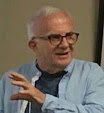If you have ever visited the Philadelphia Museum of Art, you may have seen a great and colorful mobile by Alexander Calder, one of America’s foremost modem sculptors. Calder’s mobiles are huge, welded, metallic surfaces, delicately balanced and suspended so as to move constantly with the slightest currents of air. Calder himself was one of the great and colorful characters in American life. He was noted for his love of double entendres, his shocking bluntness, and his willingness to take great artistic and personal risks. He was not noted for spirituality, piety nor for having even an inkling of religious sensibility. So the art world was puzzled when he named this Philadelphia mobile The Holy Ghost. Essays were written and theologians speculated. What could this possibly mean?
Then someone noticed that the beautiful fountain at Logan Square lay on a direct axis between the art museum and the Philadelphia City Hall. A grandiose statue of William Penn and four huge carved eagles all had been mounted on that building. They were the work of Calder’s grandfather, Alexander Milne Calder, an immigrant from Scotland. The fountain itself had been carved by Calder’s father, Alexander Stirling Calder, another prominent sculptor of the city. So naturally, when the modem “Sandy” Calder installed his work he thought of... Father, Son and... Holy Ghost!
For many people in today’s world, even in the church, talk about the Holy Spirit carries just about this level of importance. If it is thought of at all, it is considered little more than an inside joke, and as little understood. It has been called the “poor relation” of the Trinity, a bit of an embarrassment to modem minds.
In the long history of the church, on the other hand, Pentecost was and is considered the third great festival of our faith. It brings to fruition and makes real the work silently begun at Christmas and declared to the world at Easter. It celebrates the gift of the Holy Spirit, the birth of the church on earth, and the gifts of the Spirit given to us for the transformation of the world. The Holy Spirit is God’s way of being “present” now. It is “in” the Holy Spirit that we discover both our unique individuality and our deepest communion with others, our freedom and our most intimate love. The fruits of the Spirit, Paul writes to the Galatians, are love, joy, peace, patience, kindness, goodness, fidelity, gentleness, and self-control. In the creeds the Holy Spirit is worshipped as “the Lord, the Giver of Life.” The symbols of the Spirit are many; fire, dove and wind are among the most well known.
Calder’s title for his Philadelphia mobile may have been more of a double entendre than he intended. For in 1951 he wrote, “The underlying sense of form in my work has been the system of the Universe, or a part thereof. This is a rather large model.” And twenty years later he emphasized, “I work from a very large live model.” Sounds like the Spirit to me!
Thursday, May 20, 2010
Subscribe to:
Post Comments (Atom)













No comments:
Post a Comment